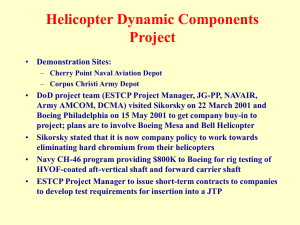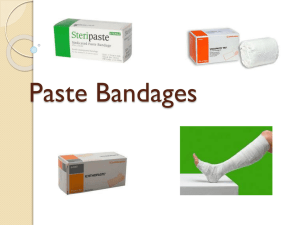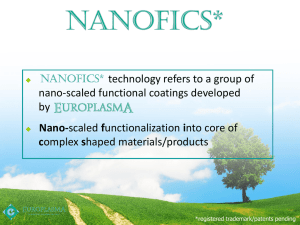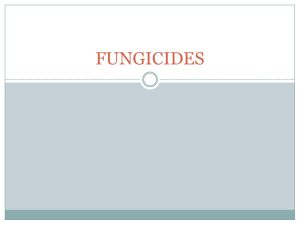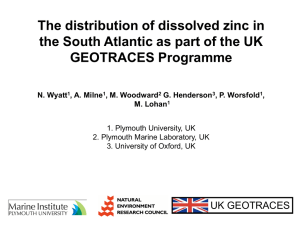F2) Environmental Considerations in The Selection of Dry Film
advertisement
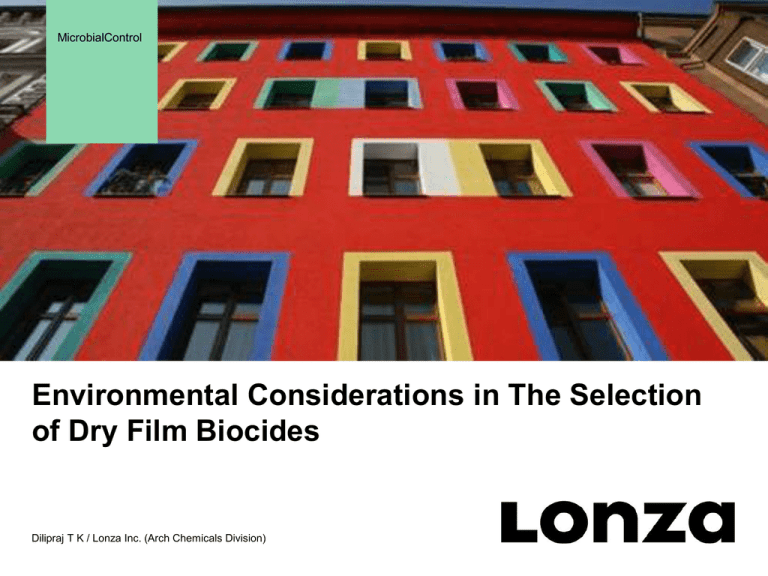
Pharma&Biotech MicrobialControl Environmental Considerations in The Selection of Dry Film Biocides Dilipraj T K / Lonza Inc. (Arch Chemicals Division) Overview Microbial control challenges for a coatings formulator The value of biocides and the impact of the lack of protection Challenges faced by a coatings formulator Multi-region dry film biocide panel study Lonza’s active agent offerings for dry film protection Limited number of biocide active agents available Need for long term and broad spectrum protection of the paint film Biocide compatibility with the paint formulation Concern about consumer perceptions opposite label warnings The ZOE formulation of Zinc Omadine™ Formulations for other active agents Study experimental design Summary of study results Introduction of Densil™ ZOD and Densil™ FAZ Support from Lonza 2 Challenges Faced by a Coatings Formulator: Compatibility Challenges for a coatings formulator Biocide compatibility with the paint formulation Paint film protection agents must……… be chemically stable & compatible with paints not affect paint application (viscosity, drying etc.) deliver long lasting film protection 3 Challenges Faced by a Coatings Formulator: Broad spectrum protection Challenges for a coatings formulator The value of biocides and the impact of the lack of protection Challenges faced by a coatings formulator Broad spectrum protection of the paint film Interior Wide variety of fungi Concern about indoor air quality; airborne fungal spores Frequent human contact with painted surfaces Exterior Wide variety of fungi Defacement by algae Increasing diversity of substrates 4 Challenges Faced by a Coatings Formulator: Limited biocide actives available Challenges for a coatings formulator Limited number of available biocide active agents Need for both long term and broad spectrum protection of the paint film Fungicidal Algaecidal Fungicidal/Algaecidal Octyl Isothiazolinone (OIT) Diuron Zinc Omadine™ (ZnOM) Dichloro Octyl Isothiazolinone (DCOIT) Irgarol N-butyl Benzisothiazolin (BBIT) Terbutryn Iodo Propynyl Butylcarbamate (IPBC) Chlorothalonil (CTL) Carbendazim (BCM) 5 Challenges Faced by a Coatings Formulator: Considering biocide solubility and spectrum Limited number of available biocide active agents Need for long term and broad spectrum protection of the paint film Active agents have different water solubility and different microbial spectrum Why is water solubility important? Biocide Active Agents Grouped by Water Solubility Group A Low Water Solubility Group B Medium Water Solubility Group C High Water Solubility Zinc Omadine™ (ZnOM) 0.008 gm/L Diuron 0.035 gm/L Octyl Isothiazolinone (OIT) 0.48 gm/L Chlorothalonil (CTL) 0.0006 gm/L DCOIT 0.014 gm/L N-butyl Benzisothiazolin (BBIT) 0.7 gm/L Carbendazim (BCM) 0.008 gm/L Terbutryn 0.025 gm/L Iodo Propynyl Butylcarbamate (IPBC) 0.168 gm/L Irgarol 0.007 gm/L 6 Challenges Faced by a Coatings Formulator: Considering biocide solubility and spectrum Need for long term and broad spectrum protection of the paint film Active agents have different water solubility and different microbial spectrum Why is water solubility important? In the conventional model of a paint film there is a reservoir of fungicide active agent in the paint film, and there is also some fungicide on the surface of the paint. As rain falls on the surface of the paint film, it washes away the fungicide on the surface, however the fungicide at the surface of the film is replenished by new fungicide that is drawn from the reservoir in the paint film. If the fungicide has too high a water solubility, then the reservoir will be depleted and the coating will show defacement O O O O O O O O O O O O O O O O O O O O O O O O O O O O O O O O O O O O O No growth O O O O O O O O O O O O O O O O O O O O O O O No growth O O O O O O O O O No growth O O O O O O O O Heavy growth 7 Challenges Faced by a Coatings Formulator: Considering biocide solubility and spectrum Group A Low Water Solubility Group B Medium Water Solubility Group C High Water Solubility Zinc Omadine™ (ZnOM) 0.008 gm/L Diuron 0.035 gm/L Octyl Isothiazolinone (OIT) 0.48 gm/L Chlorothalonil (CTL) 0.0006 gm/L DCOIT 0.014 gm/L N-butyl Benzisothiazolin (BBIT) 0.7 gm/L Carbendazim (BCM) 0.008 gm/L Terbutryn 0.025 gm/L Iodo Propynyl Butylcarbamate (IPBC) 0.168 gm/L Irgarol 0.007 gm/L If the fungicide has too low a water solubility, then not enough fungicide is pulled from the reservoir to prevent defacement O X X O X X X X X X O X X O X X X X X X O X X O X X X X X X No growth O X X O X X X X X X O O X O X X X X X X X O X X X X X X X X O X X X X X X X X Light growth O X O O O X X X X X X X X X X X X X X X X X X X Moderate growth X X X X X X X X X X X X X X X X X X X X X X X X O O O X X X Heavy growth X 8 Challenges Faced by a Coatings Formulator: Considering biocide solubility and spectrum Group A Low Water Solubility Group B Medium Water Solubility Group C High Water Solubility Zinc Omadine™ (ZnOM) 0.008 gm/L Diuron 0.035 gm/L Octyl Isothiazolinone (OIT) 0.48 gm/L Chlorothalonil (CTL) 0.0006 gm/L DCOIT 0.014 gm/L N-butyl Benzisothiazolin (BBIT) 0.7 gm/L Carbendazim (BCM) 0.008 gm/L Terbutryn 0.025 gm/L Iodo Propynyl Butylcarbamate (IPBC) 0.168 gm/L Irgarol 0.007 gm/L A combination of a less water soluble fungicide with a more water soluble fungicide gives more robust paint film protection. O X O X O X O X X O X O X O X O O X O X O X O X X O X O X O X O O X O X O X O X X O X O X O X O O X O X O X O X X O X O X O X O O O X O X X X X X X X O X O X O X O X X O X O X O X O O X O X O X O X X O X O X O X O O X O X O X O X O O O X X X X X X X X X X X X X X X X O X O X O X O X X O X O X O X O O O O X X X X X X X X X X X X X X X X X X X X 9 No growth No growth No growth No growth Challenges Faced by a Coatings Formulator: Developing a strategy for dry film protection Need for long term and broad spectrum protection of the paint film Active agents have different water solubility and different microbial spectrum Potential blend strategy Less water soluble fungicide as a foundation May include more water soluble co-fungicide May include a supplemental algaecide Troy Troy Troy Thor Thor Troysan™ 663 Troysan™ 678 Troysan™ 662 Acticide™ PA Acticide™ PM 9.0% BCM 3.0% IPBC 15.0% Diuron 15.0% BCM 5.0% IPBC 12.0% BCM 4.0% IPBC 4.0% Irgarol™ 11.8% CTL 6.0% OIT 19.0% Diuron 14.0% CTL 19.0% Diuron Dow Dow Ashland Ashland Lanxess Rocima™ 63 Rocima™ 65 Fungitrol™ 2010 Fungitrol™ 2002 Preventol™ A14D 7.5% BCM 2.7% OIT 20.0% Diuron 9.0% BCM 5.0% DCOIT 3.5% Irgarol™ 20.1% CTL 10.1% IPBC 48.0% CTL 10.0% BCM 3.0% OIT 22.0% Diuron 6.0% Irgarol™ Data Source; NPIRS http://npirspublic.ceris.purdue.edu/ppis/ 10 Challenges Faced by a Coatings Formulator: Consumer perceptions about label warnings Challenges for a coatings formulator Limited number of available biocide active agents Concern about consumer perceptions opposite label warnings For durable film protection, need a fungicide with low water solubility; Carbendazim, Chlorothalonil, Zinc Omadine™ Carbendazim Pluses Stable over wide pH range Good compatibility history with other paint ingredients Minuses Very limited activity against algae or bacteria Gaps in anti-fungal spectrum – ex. Alternaria sp. CLP / GHS labeling EU Category 2 Mutagen => GHS Category 1B 11 Challenges Faced by a Coatings Formulator: Consumer perceptions about label warnings Challenges for a coatings formulator Limited number of fungicide and algaecide active agents Concern about consumer perceptions opposite label warnings Current situation in Europe The European Union has now implemented the United Nations' GHS (Globally Harmonized System of Classification and Labeling of Chemicals) into EU law as the CLP Regulation The CLP Regulation which came into force on the 20th January 2009 requires manufacturers to: Classify, Label and Package substances and mixtures according to CLP before placing them onto the market Implementation for Substances - Dec 2010 Implementation for Mixtures (Paint) - June 2015 In 2015, in Europe, the CLP legislation will limit the fungicide and algaecide concentrations that can be in European paints without having warning statements on the paint cans EU warning statements and risk phrases for Carbendazim Health Hazard label Environmental Impact label GHS dosage thresholds 12 Carbendazim EU Labeling Requirements Carbendazim Level % Symbol Indication of Danger R and S Phrases (On Label) <0.1 0.1 - 0.25 None T None Toxic None R46, S53, S45 MSDS Phrase; Mutagen Cat 2 0.25 -0.5 T Toxic R46, R52/53, S53, S45 MSDS Phrase; Mutagen Cat 2 0.5 - 2.5 T Toxic R46, R60, R61, R52/53, S53, S45 MSDS; Mutagen Cat 2, Reprotox Cat 2* 2.5 - 25 TN Toxic Dangerous for the environment R46, R60, R61, R51/53, S53, S45, S60,S61 MSDS; Mutagen Cat 2, Reprotox Cat 2* Carbendazim must be listed on the label as a hazardous ingredient at levels >0.1% T = Skull and crossbones N = Dead fish and tree * EU/DDP classification R46 = May cause heritable genetic damage R52 = Harmful to aquatic organisms R53 = May cause long term adverse effects in the aquatic environment R60 = May impair fertility R61 = May cause harm to the unborn child R51 = Toxic to aquatic organisms Carbendazim potentially requires both health hazard and environmental hazard labels 13 Comparison of EU and GHS Criteria EU Criteria Category 1 T R46 Category 2 T R46 Category 3 Xn R68 Substances known to be mutagenic to man. Substances which should be regarded as if they are mutagenic to man. Substances which cause concern for man owing to possible mutagenic effects. GHS Criteria Category 1 Category 2 Category 1A Category 1B Chemicals know to induce heritable mutations in germ cells of humans. Chemicals which should be regarded as if they induce heritable mutations in germ cells of humans. Chemicals which cause concern for man owing to the possible that they may induce heritable mutations in germ cells of humans. Table 3.5.1 Cut-off values/concentration limits of ingredients of a mixture classified as germ cell mutagens that would trigger classification of the mixture Ingredient classified as: Cut-off/concentration limits triggering classification of a mixture as: Category 1 mutagen Category 1 mutagen Category 2 mutagen Category 2 mutagen > 0.1% > 1.0% Under GHS, Carbendazim falls into the more serious Category 1 classification 14 Challenges Faced by a Coatings Formulator: Consumer perceptions about label warnings Challenges for a coatings formulator Limited number of available biocide active agents Concern about consumer perceptions opposite label warnings Fungicides with low water solubility; Carbendazim, Chlorothalonil, Zinc Omadine™ Chlorothalonil Pluses Very low water solubility Good anti-fungal spectrum plus some activity against algae Minuses Alkaline pH hydrolysis Problematic compatibility history with other paint ingredients; pinking, yellowing Chalking in colored paints Very limited activity against bacteria CLP / GHS labeling for Chlorothalonil – Health Hazard + Environmental Impact Chlorothalonil is in IARC Group B2 => GHS Category 2 Cat 2 ≥ 0.1% but <1.0% “Some authorities will chose to label…others would not normally require a label” Cat 2 ≥ 1.0% “a label would generally be expected” Under GHS, Chlorothalonil falls into the less serious Category 2 classification 15 Challenges Faced by a Coatings Formulator: Consumer perceptions about label warnings Challenges for a coatings formulator Limited number of available biocide active agents Concern about paint compatibility and consumer perceptions opposite label warnings Need a fungicide with low water solubility; Carbendazim, Chlorothalonil, Zinc Omadine™ Zinc Omadine™ Pluses Broad spectrum; Anti-fungal, Anti-algal, Anti-bacterial Zinc Omadine™ ZOE formulation has good compatibility history with other paint ingredients CLP / GHS labeling Zinc Omadine™…. is not a mutagen, is not a carcinogen, is not a skin sensitizer EU CLP Labeling only for Environmental Impact • For ZOE, the EU threshold limit for labeling (6000 ppm ZOE) is above the typical ZOE use level Minuses Requires suppression of trans-chelation 16 Zinc Omadine™ ZOE Dispersion EU Labeling Requirements Concentration % Classification 0.1 - 0.6 R52/53 0.6 - 1.0 N; R51/53 1.0 - 2.5 N; R51/53 2.5 - 10.0 N; R50/53 N = Dead fish and tree R50/53 : Very toxic to aquatic organisms, may cause long-term adverse effects in the aquatic environment R51/53: Toxic to aquatic organisms, may cause long-term adverse effects in the aquatic environment R52/53 Harmful to aquatic organisms, may cause long-term adverse effects in the aquatic environment Zinc Omadine™ does not require health hazard labels, it requires environmental hazard labels only at ZOE dosages above 6000 ppm, and only in regions where environmental hazard labeling is required 17 Challenges Faced by a Coatings Formulator: Consumer perceptions about label warnings Challenges for a coatings formulator Limited number of available biocide active agents Select Zinc Omadine™ as low solubility active agent for durable protection of the paint film Need a supplemental algaecide? In many situations Zinc Omadine™ alone has sufficient anti-algal activity However, panel testing shows some situations where a supplemental algaecide helps Available supplemental algaecides; Diuron, Irgarol™, Terbutryn Consider cost effect – Diuron offers good value Consider spectrum – Diuron contributes to anti-fungal activity Consider CLP / GHS label All algaecides will have Environmental Impact Diuron – Health Hazard + Environmental Impact Diuron is EU Category 3 => GHS Category 2 Cat 2 ≥ 0.1% <1.0% “Some authorities will chose to label…others would not normally require a label” Cat 2 ≥ 1.0% “a label would generally be expected” On balance, Diuron is preferred Under GHS, Diuron falls into the less serious Category 2 classification 18 Challenges Faced by a Coatings Formulator: Developing a strategy for dry film protection Challenges for a coatings formulator Limited number of available biocide active agents Select Zinc Omadine™ as durable fungicide + Diuron as supplemental algaecide Benefits from a co-fungicide with higher water solubility; OIT or BBIT or IPBC ? Look at active combinations, and active ratios DS 6337, DS 6338: Zinc Omadine™ + Diuron + OIT (Isocil™ WT Fungicide) DS 6338 alt.: Zinc Omadine™ + Diuron + BBIT (Densil™ DN Antimicrobial) DS 6372, DS 6373: Zinc Omadine™ + Diuron + IPBC (Omacide™ Fungicides) Test under different conditions Different paint types, Different substrates, Different exposure conditions Consider cost effect Evaluate overall performance Zinc Omadine™ + Diuron + OIT performs better overall than the other two combinations DS 6338 (with OIT) was the best performing ratio of these active agents => Densil™ ZOD Formulating Densil™ ZOD with OIT concentrate avoids introduction of VOC 19 Panel Study – Experimental Design Problem Background Panel studies conducted in multiple regions – Project Bristle Substrates, painting practices, etc. selected as appropriate for each region Zinc Omadine™ as foundation, vary secondary algaecide inclusion, vary co-fungicides Findings Durable film protection in geographical areas with high algal pressure Identify biocide options consistent with local regulatory environment Need different secondary algaecide or different co-fungicide for different global regions Need different active agent ratios for different global regions Results Commercialize DS 6338 as Densil™ ZOD as a global product Commercialize DS 6408 as Densil™ FAZ (alt. ratio; ZnOM/OIT/Diuron) for Asia Commercialize other products for other regions US Test Site EU Test Site India Test Site S. Asia Test Site 20 Panel Study – Active Agents Lonza’s biocide offerings for dry film protection Broad spectrum antimicrobials Durable film protection Biocide formulations optimized for use in coatings Active Agent Biocide Product Active Agent Biocide Product ZnOM Zinc Omadine™ ZOE Antimicrobial OIT Isocil™ WT Fungicide Zinc Omadine™ Powder Antimicrobial IPBC Omacide™ IPBC 40 Fungicide CLT Zinc Omadine™ FPS Antimicrobial Omacide™ IPBC 30 Fungicide Densil™ C40 Antimicrobial Omacide™ IPBC 20 Fungicide Omacide™ IPBC 100 Fungicide BBIT Densil™ DN Antimicrobial Densil™ DG45 Antimicrobial 21 Panel Study – Zinc Omadine™ Formulation Zinc Omadine™ ZOE Antimicrobial Zinc Omadine™ provides durable dry film protection against both fungi and algae Advantages of Zinc Omadine™ ZOE Antimicrobial Biocide formulation optimized for use in coatings The ZOE formulation has good compatibility history with other paint ingredients The ZOE formulation contains proprietary Lonza technology to suppress Zinc Omadine™ trans-chelation Broad range of pH stability; Excellent thermal stability Zero VOC Can be used for both Interior and Exterior paints Interior paints are increasingly being rated for mold resistance Zinc Omadine™ is familiar to consumers as the world’s leading anti-dandruff agent Well established track record of safety in skin contact applications Compliant with upcoming regulations EU CLP trigger concentration for Environmental Hazard label above typical use level No anticipated Health Hazard labeling post U.S. GHS implementation 22 Panel Study - Test Fence Results Summary North Vertical Wood - Flat- 12 Months 10 9 8 7 6 Rating 10 9 8 6 4 2 0 Description No Fungal Growth Trace Slight Moderate Pronounced Severe Complete Coverage 5 4 3 Low Dosage Medium Dosage 2 High Dosage 1 0 23 Panel Study - Test Fence Results Summary North Vertical HP - Flat- 24 Months 10.0 9.0 8.0 7.0 6.0 Rating 10 9 8 6 4 2 0 Description No Fungal Growth Trace Slight Moderate Pronounced Severe Complete Coverage 5.0 4.0 3.0 Low Dosage Medium Dosage 2.0 High Dosage 1.0 0.0 24 Panel Study - Test Fence Results Photographs Panel Photos from S. Florida Test Fence Lab made standard acrylic flat paint BLANK Primed southern yellow pine NEG CTRL AVG = 4.6 Exposure 90 North vertical 34 MONTHS Photos were taken at 33 months Ratings shown are for 34 months DENSIL™ ZOD DS 6338 3 ACTIVE BLEND MID DOSAGE AVG = 7.0 34 MONTHS DS 6386 2 ACTIVE BLEND MID DOSAGE AVG = 6.0 34 MONTHS POS CTRL MID DOSAGE AVG = 4.9 34 MONTHS DS 6338 alt. 3 ACTIVE BLEND MID DOSAGE AVG = 7.0 34 MONTHS Rating 10 9 8 6 4 2 0 Description No Fungal Growth Trace Slight Moderate Pronounced Severe Complete Coverage 25 New Products from Panel Study Introducing - Densil™ ZOD Antimicrobial Three active dry film biocide blend for exterior coatings Zinc Omadine™ as the durable less water soluble fungicide OIT as the more water soluble co-fungicide Diuron as the supplemental algaecide EPA reg. # 1258-1345 Use patterns: Paints and Stains, Masonry Coatings, Plasters, Caulks and Sealants, Stucco, Mastics, and Joint Cements Advantages of Densil™ ZOD Antimicrobial Combination of fungicides with different water solubility gives more robust paint film protection Fungicide blend with secondary algaecide covers a broader range of coating scenarios Biocide formulation optimized for use in coatings Densil™ ZOD contains proprietary Lonza technology to suppress Zinc Omadine™ trans-chelation Zero VOC Expected to be compliant with upcoming U.S. regulations Health Hazard labeling post U.S. GHS implementation expected to be above typical Densil ZOD use levels 26 New Products from Panel Study Introducing - Densil™ FAZ Antimicrobial Designed for use in high volume paints Three active dry film biocide blend for exterior coatings Proportions of active agents differs from Densil ZOD Densil FAZ has higher ratio of Diuron / (Zinc Omadine™ + OIT) Consider the impact of geography and climate Some tropical environments have very high algal pressure The concentration of algaecide needed may determine the overall biocide dosage required Having different ratios available provides flexibility for variations in climate and paint formulation Advantages of Densil™ FAZ Antimicrobial Combination of fungicides with different water solubility gives more robust paint film protection Fungicide blend with secondary algaecide covers a broader range of coating scenarios Biocide formulation optimized for use in coatings Densil™ FAZ contains proprietary Lonza technology to suppress Zinc Omadine™ trans-chelation Zero VOC 27 Summary – Lonza Support Lonza’s biocide offerings for dry film protection Support from Lonza Corporate level commitment to continual improvement in EHS areas Strong global regulatory and toxicology expertise and support Strong microbiological and analytical chemistry support Newly opened Innovation Center in Alpharetta, Georgia On-going exploration of leading edge technologies Strong corporate focus on Material Protection and Industrial Solutions Development of products that are consistent with current requirements but are also aligned with trends and anticipated future market needs 28 Thank You!
